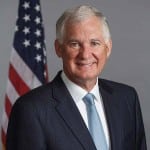
Science Applications International Corp. [SAIC] on Thursday posted higher sales and net income with the results driven by the company’s acquisition of Engility in January and improved performance across its portfolio. Sales were up 37 percent to $1.6 billion from nearly $1.2 billion a year ago, with all of the growth coming from Engility as organic revenue declined 3 percent. The first quarter was the only one this fiscal year that organic growth is expected to contract and will be…

 By
By 











